Can you imagine how a Project by 3 college graduates with no prior experience in startups could turn into a multi-billion dollar company without raising excessive capital in just a few years?
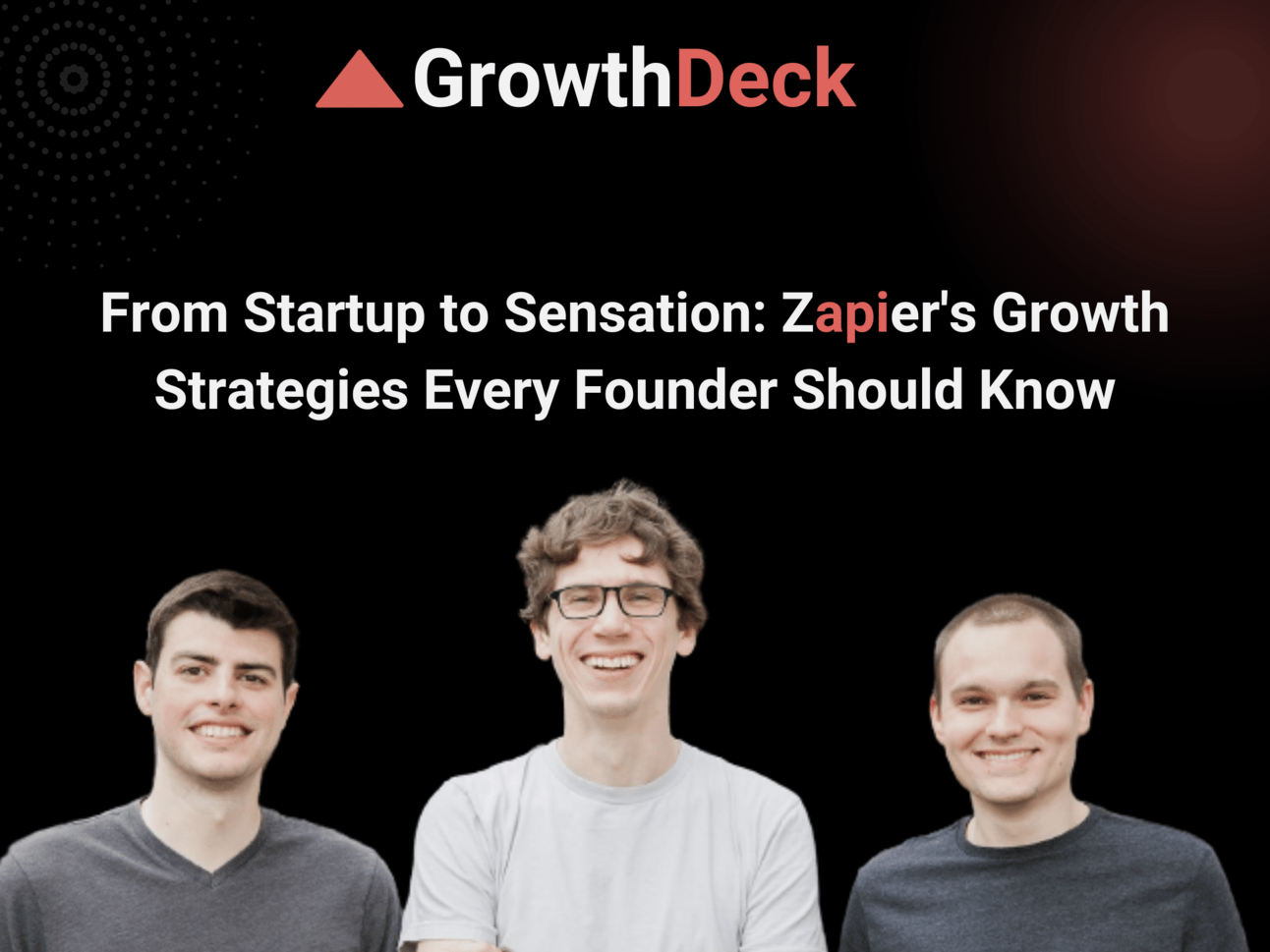
In this article, I'll be going through the history of Zapier, the problem they are solving, the growth drivers they used, and some key learnings from Zapier.
Here is a brief roadmap of the contents we will be discussing in this article

So What Exactly Is Zapier?
It automates the whole process of "If X happens do Y". It works on triggers and actions. Think of the trigger as an event. For instance, consider you have a Typeform and when you receive a response, you need to notify your team in a Slack channel. You can implement this whole process with a few clicks with the help of Zapier.

This was just a simple example you can develop more complicated zaps as per your need. Here is a youtube tutorial that dives deeper into developing more complex Zaps (Link).
Background Story And How Big Is Zapier?
Zapier was founded by Wade Foster, Bryan Helmig, and Mike Knoop in October 2011 as a side project. Initially, the app was named API Mixer however after some time, they renamed it to zAPIer. Soon after building an MVP, they applied to Y Combinator but were rejected. Yet the founders continued to build, ship, and test the app one feature and one customer at a time.
The story behind Zapier getting its early customers is very interesting. In the earlier days, the product wasn't refined enough that customers could set up integrations independently. So what Wade would usually do is he’d go to different forums and try to identify if someone needs an integration. He would simply comment:
“hey, here’s how you can do it… here are the API docs to these two services, and if you know how to code, here’s how you can make it work. OR, I’m working on a project that will make an integration for this and if you want to find out more, go to this link and let me know."
This is how Zapier got its initial customers. After a year they again applied to Y Combinator and this time they got accepted. This time they not only had a better working product but also had more integrations and 10,000 people on their waitlist.
They have only raised one seed round of $1.4 million to date. Following that, the company declared itself profitable and has never raised funds since. Zapier has not disclosed the number of users it currently has. However, if we make a conservative guess based on various sources and their growth trajectory, the total number of Zapier users would be around 4 million.
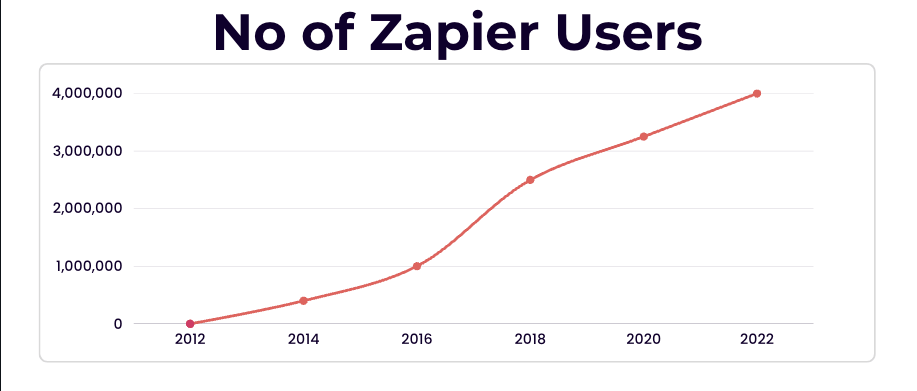
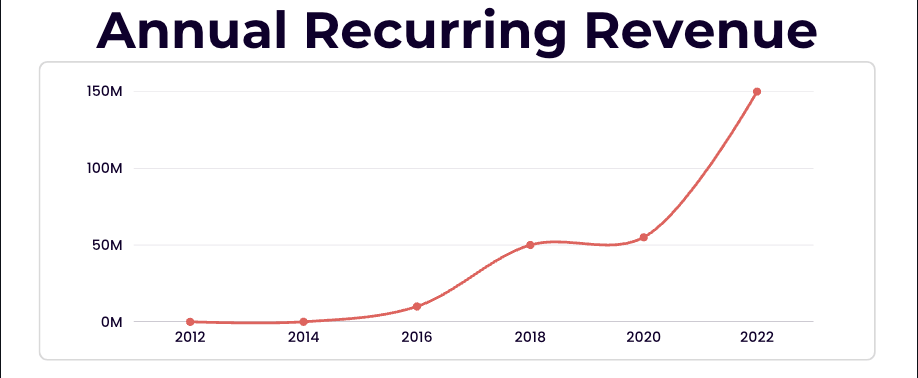
Now that we have an Idea about what and how big Zapier is? Let’s dive into various growth drivers used by Zapier. What exactly did Zapier do that helped them achieve this amount of success?
Growth Drivers
1. Outstanding SEO Strategy
SEO has been one of the key factors that have significantly helped Zapier grow.
Zapier receives approximately 9M unique site visits per month. And the majority of its traffic comes from search.
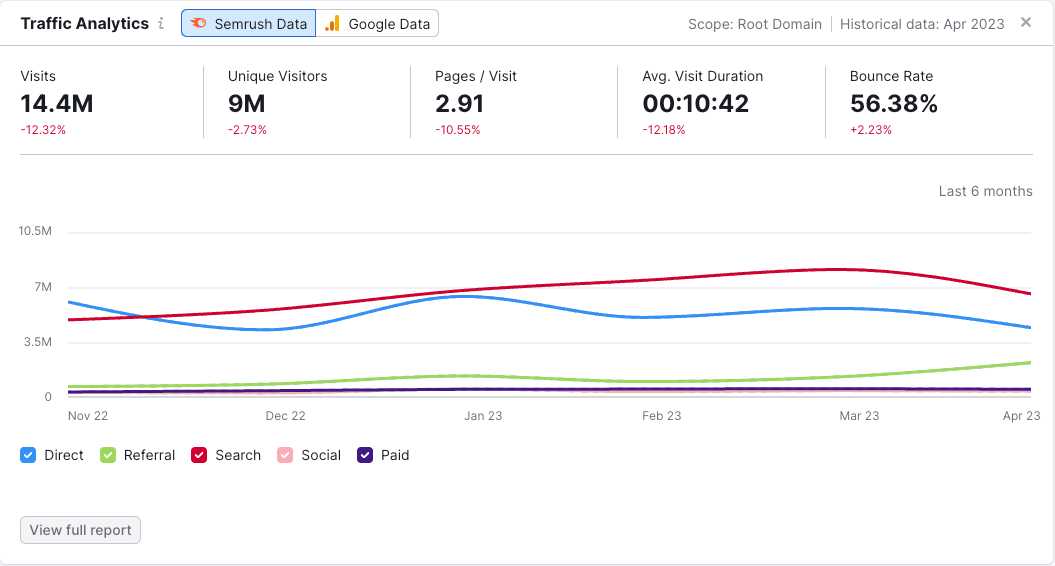
Zapier used a diversified set of programmatic SEO strategies to grow. These SEO strategies were not just limited to standard SEC tactics that almost every other SAAS products usually use like Sponsored ads, Content Marketing, etc (More on this later).
Multiple landing pages for all combinations of apps
Zapier has a separate landing page for almost all combinations of apps. So if you search “Use google forms with Slack” Zapier has your back. It is clear that creating thousands of pages of relevant content and information for each app is a difficult task. Usually when it comes to generating similar pages, what most companies do is they pick a standard template and replace the content for each page as required. However, Zapier identified how every single page could affect the SEO, and they tried to provide unique and relevant content for each and every page. Their website does have some templated structure however, non of it is auto-generated. All of its content is specifically tailored to the need and is human-generated.
In order to generate the content they leveraged the power of outsourcing the Content to the integration partners.
Instead of writing the whole content themselves, Zapier asked the applications to provide details about their app as a part of onboarding. This way Zapier collected the information about the apps that were not only coming directly from the app owners who have a better understanding of app use cases and scenarios but also was of high quality and tailored towards their users’ needs. In order to achieve this they also provided detailed guidelines to the partners to achieve the task. This simple step helped them to avoid tons of manual work and helped them to set up content generation for each landing page programmatically.
Apart from this, Zapier also emphasized to each of its partners to list Zapier’s integration on their website which include a backlink to Zapier’s own site. Additionally, they asked their partners to make social media announcements.
This helped them to achieve initial traction and backlinks to their site. Today Zapier has around 5M backlinks.

Most recently, they have switched to shorter content yet more relevant and interactive content. For instance, if you search “Google Forms and Slack”, Zapier has suggested templates and potential use cases for the integration.

Moreover, they have added similar app suggestions and tutorials. On the very same page, they also provide suggestions on how the process can be further enhanced by adding one more app to the flow.

Zapier has now transformed into a complete programmatic SEO approach. Here are the results of its total organic keyword search that has helped Zapier.
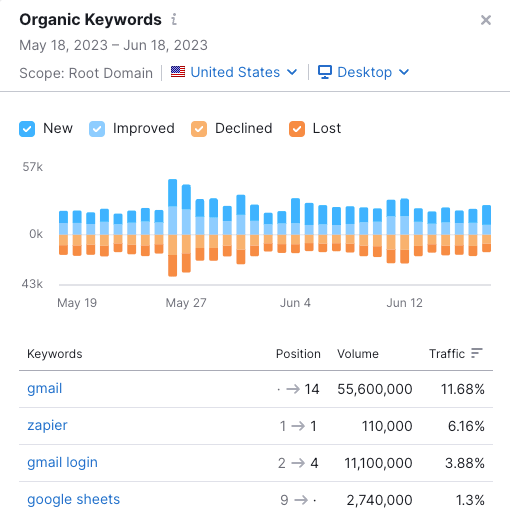
Integration platforms like Zapier face the invisibility problem which means that their product has no direct interaction with the user but rather it works as an intermediate bridge between the application which often goes unnoticed. In order to solve this problem, Zapier decided to use their integration partners as their top promoters.
Beyond Backlinks - How Zapier leveraged backdoors to gain traffic.
Multiple landing pages for apps have worked great for customers and Zapier but there are customers who don’t have any specific applications in mind and are just trying to find a solution to their problem.
Zapier did an outstanding job in targeting these customers. Basically, SEO is all about a customer facing a problem, you offer a solution to that problem. And the solution is usually accompanied by a better solution where you introduce your product.
Take a look at this blog by Zapier (How to organize files and folder). It is just a basic simple blog that describes tips for efficient file management. However, Zapier does a fantastic job at using these blogs as a backdoor and pitching their product.
If you scroll to the end of the blog, you’ll find:
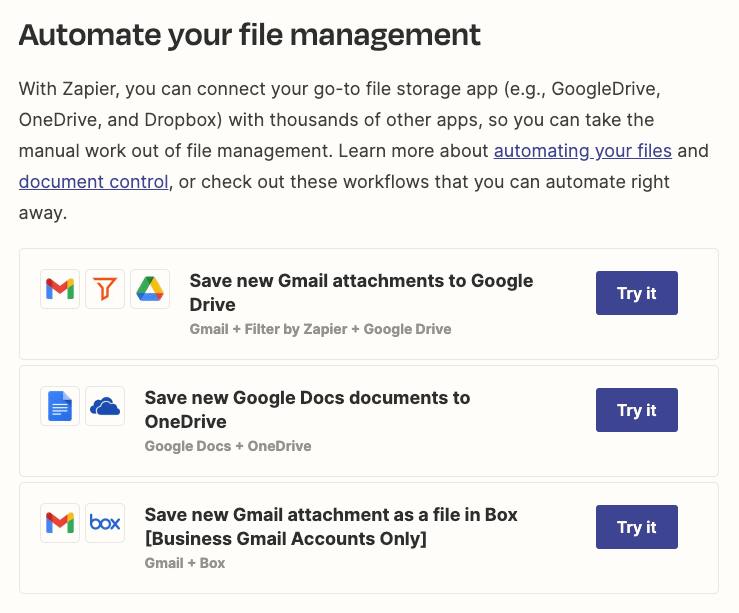
If you notice closely, Zapier used the exact strategy mentioned above to cleverly pitch their product. They targeted the users who are facing problems with file management, they offer and solution to that problem, and on top of that, they provided a better solution to them by using integrations and thereby introducing their product.
Apart from that Zapier used several other strategies to grow their SEO, for the sake of simplicity and helping you not get carried away, I have briefly mentioned them below:
Using Topic clusters for their content - Meaning organizing current content into a content cluster and expanding that cluster by adding more content to it.
Using link-baiting.
Using densely internet-connected mesh of pages.
All in all, Zapier implemented programmatic pages as part of their SEO strategy to attract highly interested visitors during the early stages of their growth. These pages focused on low competition, specifically branded keywords, and experienced rapid growth in terms of traffic soon after launch. However, due to increased competition and other factors, the traffic to these programmatic pages eventually reached a plateau. Despite this, Zapier recognized the importance of long-term potential and concurrently concentrated on gradually building their blog content and backlink authority.
Excellent Customer Service
The founders of Zapier deeply believe in providing the best customer service.
…We can’t be the best and we can’t be the cheapest, but we can definitely care the most, and so from day one, we thought, ‘let’s get on Skype calls, let’s do things that might not scale right now, just so that we can make people really happy and really want to work with us.’ When you’re very early stage… you don’t need a thousand customers, you just need one customer or ten customers, and we were able to go from nothing to something just through this very targeted outreach
In the earlier days, the founders were hyperactive on various application forms trying to identify the pain points of customers and building Zapier in such a way that it can better help the customers.
Someone would ask, ‘Why doesn’t this app have an integration with this?’ And we’d say, ‘Hey, you can use the API to build this stuff, and we can help you out.’ Each time we did this, we’d get a few new beta customers. And that’s exactly what we needed in the early days. It took us probably eight months of proactively reaching out to customers before we got our first inbound request, someone asking “Hey, how do I get my app on Zapier?
Zapier’s attention to customer service can be clearly seen by how it operated in earlier days. Whenever there was an issue with the application, the founders and the team hopped on a call with the client and fixed the issue right away. This level of customer service stood out and made a huge impact on the company’s success.
At Zapier, every employee is required to provide customer service. Founders believe that customer service is extremely important and it should be the responsibility of each and every employee irrespective of their positions. They believe that without doing customer service, the team can not identify the customer's needs, problems, and frustrations. Wade the CEO of Zapier stills provides customer service when gets time.
Customer service is deeply in the roots of Zapier, even their hiring process is curated in such a way that it accounts for customer serving abilities for a candidate for each and every role.
Exceptional Pricing Strategy
Let's dive into the pricing strategy used by Zapier:
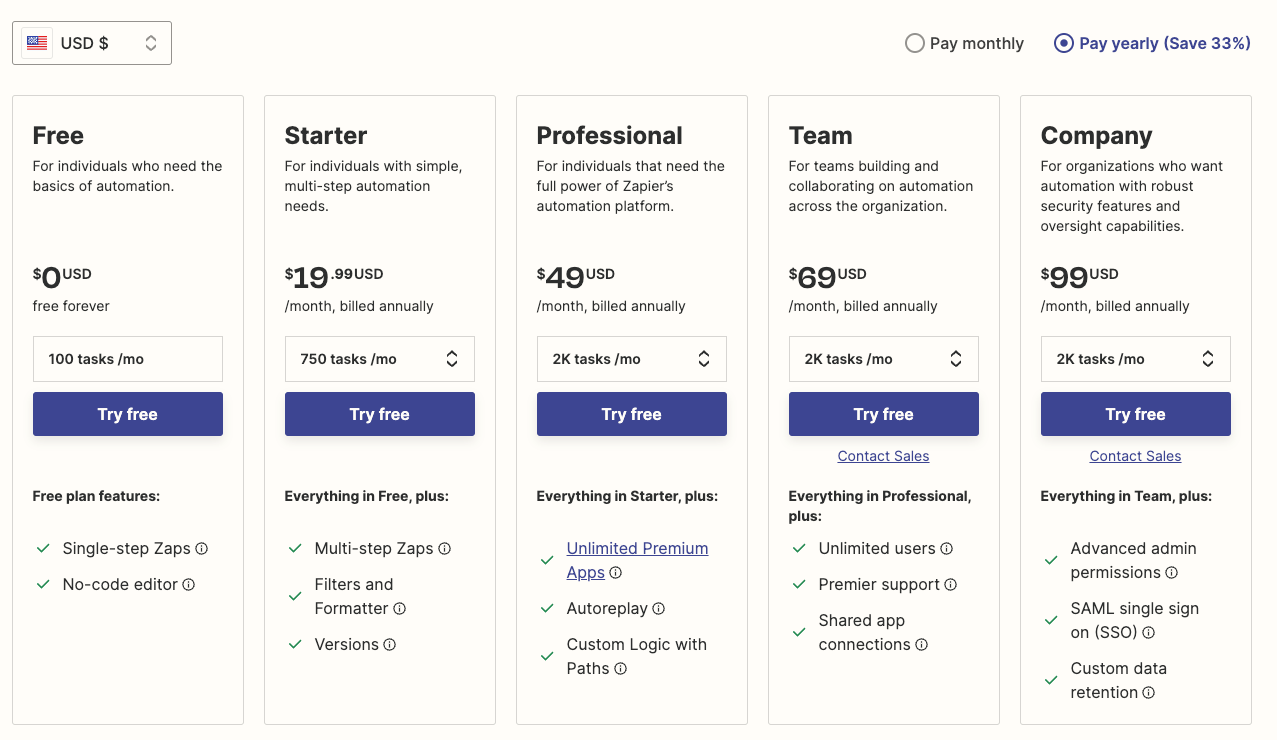
As of 25 - June 2023
It can be seen that Zapier uses a usability-based, 5-tier pricing model and is highly influenced by the number of Zaps and Tasks.
Zap is a complete automation workflow created in Zapier, consisting of a trigger and one or more actions. Each individual action performed within a Zap is counted as a task. So, the number of tasks you use determines the pricing and usage limits in Zapier's plans.
Instead of free-trail which most of the SAAS applications nowadays go with, Zapier still provides a freemium plan which allows anyone to try out and use Zapier with basic features at no cost. Thus it significantly reduces the onboarding constraints for new customers. Once the customer starts using Zapier they are charged as per their usage. This simply means that the more you use the more you pay. This way, Zapier has developed a loop that employs More Usage → Higher Price → More Trust.
The product aims for scalability by eliminating function stacking and growing horizontally within a solid mathematical structure. Zaps in Zapier has a stable tree-like structure that can handle complex scenarios. Predefined Zap templates help customers quickly create Zaps aligned with their specific needs.
Plans provided by Zapier provide quite distinctive and useful value, unlike other SAAS providers who usually add one or two NOT too useful features to premium plans. With Zapier, each plan has its own benefits. With increased Zaps and Tasks, you also get additional features like the ability to build multi-step Zaps, Zap trees, Filters, and Formatters to modify and play with the data, version controls, custom logic, multiple users, and much more.
While these new features have been recently introduced aside, Zapier primarily focused on its core product in the earlier days rather than horizontally expanding and providing new useless features. Most of the SAAS especially the ones that have received funding, operate horizontally by proving unnecessary useless features while focusing less on core features.
“Your product is defined by its basic feature”
Lean Approach
From the beginning, Zapier has always followed a lean approach. They never hired someone until and unless it was extremely necessary. The founder did most of the work themselves in the earlier days.
They have always been working remotely since Y Combinator. When it comes to hiring, the founders believe that:
We’ve always things hired people who care about the same things as us. We wanted people who cared a lot about doing really good work, and who cared about building high quality stuff rather than having ping pong tables or massages at work.
Having folks who cared about the same stuff as we did made it a lot easier to gel as a team.
They have always believed in hiring people slowly and purposefully. Their attention to detail in hiring can be seen here:

A picture from Zapier’s Backend server. I found it while I was looking for bugs in Zapier’s API
This level of attention to detail in hiring quality engineers, an amazing product, and fantastic customer service really goes a long way. Certainly way more than $5b valuation :)
That’s all for today. Thanks for reading and don’t be shy to leave your comment if you have any. Also, please consider following us on Twitter (Keval Jagani, Meet Shukla) and sharing this newsletter.